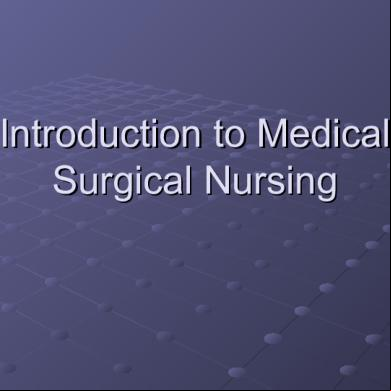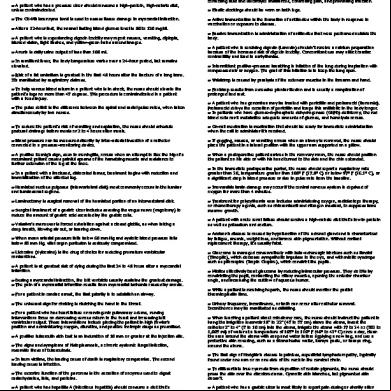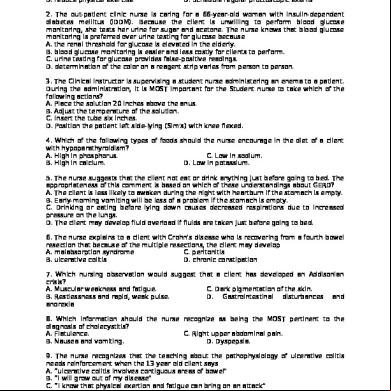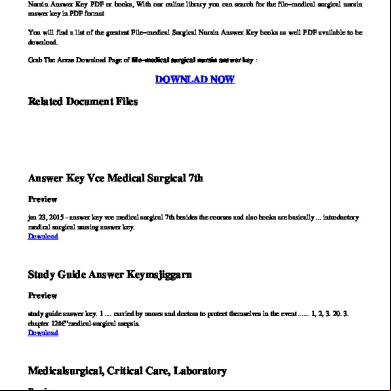Introduction -to Medical Surgical Nursing 2h3442
This document was ed by and they confirmed that they have the permission to share it. If you are author or own the copyright of this book, please report to us by using this report form. Report 2z6p3t
Overview 5o1f4z
& View Introduction -to Medical Surgical Nursing as PDF for free.
More details 6z3438
- Words: 1,344
- Pages: 24
Introduction to Medical Surgical Nursing
Evolution and trends of medical surgical Nursing
Evolution Medical Surgical nursing 1. In ancient times, when medical lore was associated with good or evil spirits, the sick were usually cared for in temples and houses of worship. 2. These women had no real training by today's standards, but experience taught them valuable skills, especially in the use of herbs and drugs, and some gained fame as the physicians of their era.
In the 17th cent., St. Vincent de Paul began to encourage women to undertake some form of training for their work, but there was no real hospital training school for nurses until one was established in Kaiserwerth, , in 1846. There, Florence Nightingale received the training that later enabled her to establish, at St. Thomas's Hospital in London, the first school designed primarily to train nurses rather than to provide nursing service for the hospital Similar schools were established in 1873 in New York City, New Haven (Conn.), and Boston.
Nursing subsequently became one of the most important professions open to women until the social changes brought by the revival of the feminist movement that began in the 1960s. During the late nineteenth and early twentieth centuries in the United States, adult patients in many of the larger hospitals were typically assigned to separate medical, surgical, and obstetrical wards. Nursing education in hospital training schools reflected these divisions to prepare nurses for work on these units
Early National League of Nursing Education (NLNE) curriculum guides treated medical nursing, surgical nursing, and disease prevention (incorporating personal hygiene and public sanitation) as separate topics. By the 1930s, however, advocates recommended that medical and surgical nursing be taught in a single, interdisciplinary course, because the division of the two was considered an artificial distinction. Surgical nursing came to be seen as the care of medical patients who were being treated surgically. The NLNE's 1937 guide called for a “Combined Course” of medical and surgical nursing
Students were expected to learn not only the theory and treatment of abnormal physiological conditions, but also to provide total care of the patient by understanding the role of health promotion and the psychological, social, and physical aspects that affected a patient's health. While the integration of this approach into nursing school curricula 1960s, nursing schools emphasized the interdisciplinary study and practice of medical and surgical nursing. 1960s and 1970s, standards were developed for many nursing specialties, including medical-surgical nursing.
Standards, Medical-Surgical Nursing Practice, written by a committee of the Division on Medical-Surgical Nursing of the American Nurses' Association (ANA), was published in 1974. It focused on the collection of data, development of nursing diagnoses and goals for nursing, and development, implementation, and evaluation of plans of care.
A Statement on the Scope of Medical-Surgical Nursing Practice followed in 1980.
In 1991, the Academy of Medical-Surgical Nurses (AMSN) was formed to provide an independent specialty professional organization for medical-surgical and adult health nurses. . In 1996, the AMSN published its own Scope and Standards of Medical-Surgical Nursing Practice, The second edition appeared in 2000 [15]. Both the ANA and AMSN documents stated that while only clinical nurse specialists were expected to participate in research, all medical-surgical nurses must incorporate research findings in their practice.
Trends in medical surgical nursing Recent trends affecting nursing as a whole have also affected medical-surgical nurses, including
the increasing use of nursing case management, expansion of advanced practice nursing, total quality improvement, development of clinical pathways, changes in the professional practice model to include greater numbers of nonprofessional staff, health care reform, and the rise of managed care. The trend toward increased acuity of patients, begun in the 1980s, has become a fact of life.
Influences on future nursing practice 1. 2. 3. 4. 5.
Expanding knowledge & technology Healthy people initiatives Evidence based practice Standardized nursing terminologies Health care informatics Nursing informatics
Nursing specialty ed Nurse Licensure Addiction nurse Ambulatory care nurse Perianathesia nurse Cardiac/vascular Nurse Critical care nurse Emergency nurse Flight nurse Dialysis nurse
Bachelor’s degree in Nursing First assistant nurse Holistic nurse Home health nurse Home health nurse Nursing istration School nurse
Masters/higher degree in nursing
1. Nurse practioneer
Acute care NP, adult care NP, Family NP, gerontological NP, Palliative Care NP, Pediatric NP.
2. Clinical specialist Adult psychiatric & mental health nursing, community health nursing, medical surgical nursing, palliative and pediatric nursing
3. Others Advanced nursing istration Advanced oncology clinical specialist Clinical nurse leader
History of nursing Societal Trends Influencing the Development of Nursing Social Trends
Ancient Civilizations Care of sick was related to physical maintenance & comfort
first by family , relatives , servants or prisoners eventually by religious orders or humanitarian societies
Mental Health
Linda Richards and Dorthea Dix worked to improve the care of the mentally ill
Modern Civilization
focus in on technology
Societal Trends Influencing the Development of Nursing Religious Tradition-Catholic/Protestant
Courage care of sick in battlefields, military/naval hospitals and prisons care of sick and dying during epidemics
cholera, typhus, smallpox
Sacrifice Creativity
founding of Alcoholic Anonymous & Al-Anon
Comion
Societal Trends Influencing the Development of Nursing Women’s Movement
Nursing has been a premiere political force for women’s rights Nurse’s organized the first major professional organization for women edited & published the first professional magazine by a female
Martha Danger was a public health nurse in New York
opened the first birth control clinic in U.S. because of large number of unwanted pregnancies in the working poor
Lavina Dock was a writer & political activist
early feminist devoted to women’s suffrage participated in protest & demonstrations until age of the 19th Amendment in 1920 Cultural Factors first major professional group to integrate black & white
Wars Nightingale in the Crimean War
mortality rate dropped from 60% to 2% as a result of the environmental changes she implemented
Clara Barton organized nurses to provide care in the American civil War and established the American Red Cross that serves in war and peace time American Red Cross was responsible for recruiting women for the Army Nurse Corp during WWI Their motto was , American Nurses for American Men
Economic Factors Insurance
Fee for service Managed care
Cost of health care rising faster than inflation
Educational Factors 1893 Dock with Isabel Hampton Robb and Mary Nutting founded the American Society of Superintendents of Training Schools for Nurses of the U.S. and Canada
this organization was very politically active & became the NLN which promotes quality nursing education to this day
Political Factors Nightingale was political
first nurse to exert political pressure on government influential in reforming hospitals & implementing public health policies in Britain
Clara Barton persuaded Congress in 1882 to ratify the Treaty of Geneva so the Red Cross could perform in peace time
impacted on national & international pollicies
Lillian Wald’s political pressure lead to the creation of the U.S. Children’s Bureau
established by congress in 1912 to oversee child labor laws
Nursing represents 67% of healthcare providers in the U.S.
few nurses are in positions where they can influence health care policy making
1990s - Nurses became involved in politics at the local, state & national level Eddie Bernice Johnson into U.S. House of Representatives from Texas Ada Sue Hinshaw directed the NIH Center for Nursing Research Nurses in all practice areas are affected by public policy on a daily basis this demands that all nurses be proactive in policy development
Nursing’s Agenda for Health Care Reform developed in 1991 nurses can use this agenda to unite and become a political force in health care delivery
Groups of practitioners who band together to perform social or political functions they could not do alone Define & regulate the profession Development of a knowledge base for practice
Research
Transmit norms, values, knowledge, and skills Communicate/advocate contributions of the profession Address social & general welfare needs
Thank you
Evolution and trends of medical surgical Nursing
Evolution Medical Surgical nursing 1. In ancient times, when medical lore was associated with good or evil spirits, the sick were usually cared for in temples and houses of worship. 2. These women had no real training by today's standards, but experience taught them valuable skills, especially in the use of herbs and drugs, and some gained fame as the physicians of their era.
In the 17th cent., St. Vincent de Paul began to encourage women to undertake some form of training for their work, but there was no real hospital training school for nurses until one was established in Kaiserwerth, , in 1846. There, Florence Nightingale received the training that later enabled her to establish, at St. Thomas's Hospital in London, the first school designed primarily to train nurses rather than to provide nursing service for the hospital Similar schools were established in 1873 in New York City, New Haven (Conn.), and Boston.
Nursing subsequently became one of the most important professions open to women until the social changes brought by the revival of the feminist movement that began in the 1960s. During the late nineteenth and early twentieth centuries in the United States, adult patients in many of the larger hospitals were typically assigned to separate medical, surgical, and obstetrical wards. Nursing education in hospital training schools reflected these divisions to prepare nurses for work on these units
Early National League of Nursing Education (NLNE) curriculum guides treated medical nursing, surgical nursing, and disease prevention (incorporating personal hygiene and public sanitation) as separate topics. By the 1930s, however, advocates recommended that medical and surgical nursing be taught in a single, interdisciplinary course, because the division of the two was considered an artificial distinction. Surgical nursing came to be seen as the care of medical patients who were being treated surgically. The NLNE's 1937 guide called for a “Combined Course” of medical and surgical nursing
Students were expected to learn not only the theory and treatment of abnormal physiological conditions, but also to provide total care of the patient by understanding the role of health promotion and the psychological, social, and physical aspects that affected a patient's health. While the integration of this approach into nursing school curricula 1960s, nursing schools emphasized the interdisciplinary study and practice of medical and surgical nursing. 1960s and 1970s, standards were developed for many nursing specialties, including medical-surgical nursing.
Standards, Medical-Surgical Nursing Practice, written by a committee of the Division on Medical-Surgical Nursing of the American Nurses' Association (ANA), was published in 1974. It focused on the collection of data, development of nursing diagnoses and goals for nursing, and development, implementation, and evaluation of plans of care.
A Statement on the Scope of Medical-Surgical Nursing Practice followed in 1980.
In 1991, the Academy of Medical-Surgical Nurses (AMSN) was formed to provide an independent specialty professional organization for medical-surgical and adult health nurses. . In 1996, the AMSN published its own Scope and Standards of Medical-Surgical Nursing Practice, The second edition appeared in 2000 [15]. Both the ANA and AMSN documents stated that while only clinical nurse specialists were expected to participate in research, all medical-surgical nurses must incorporate research findings in their practice.
Trends in medical surgical nursing Recent trends affecting nursing as a whole have also affected medical-surgical nurses, including
the increasing use of nursing case management, expansion of advanced practice nursing, total quality improvement, development of clinical pathways, changes in the professional practice model to include greater numbers of nonprofessional staff, health care reform, and the rise of managed care. The trend toward increased acuity of patients, begun in the 1980s, has become a fact of life.
Influences on future nursing practice 1. 2. 3. 4. 5.
Expanding knowledge & technology Healthy people initiatives Evidence based practice Standardized nursing terminologies Health care informatics Nursing informatics
Nursing specialty ed Nurse Licensure Addiction nurse Ambulatory care nurse Perianathesia nurse Cardiac/vascular Nurse Critical care nurse Emergency nurse Flight nurse Dialysis nurse
Bachelor’s degree in Nursing First assistant nurse Holistic nurse Home health nurse Home health nurse Nursing istration School nurse
Masters/higher degree in nursing
1. Nurse practioneer
Acute care NP, adult care NP, Family NP, gerontological NP, Palliative Care NP, Pediatric NP.
2. Clinical specialist Adult psychiatric & mental health nursing, community health nursing, medical surgical nursing, palliative and pediatric nursing
3. Others Advanced nursing istration Advanced oncology clinical specialist Clinical nurse leader
History of nursing Societal Trends Influencing the Development of Nursing Social Trends
Ancient Civilizations Care of sick was related to physical maintenance & comfort
first by family , relatives , servants or prisoners eventually by religious orders or humanitarian societies
Mental Health
Linda Richards and Dorthea Dix worked to improve the care of the mentally ill
Modern Civilization
focus in on technology
Societal Trends Influencing the Development of Nursing Religious Tradition-Catholic/Protestant
Courage care of sick in battlefields, military/naval hospitals and prisons care of sick and dying during epidemics
cholera, typhus, smallpox
Sacrifice Creativity
founding of Alcoholic Anonymous & Al-Anon
Comion
Societal Trends Influencing the Development of Nursing Women’s Movement
Nursing has been a premiere political force for women’s rights Nurse’s organized the first major professional organization for women edited & published the first professional magazine by a female
Martha Danger was a public health nurse in New York
opened the first birth control clinic in U.S. because of large number of unwanted pregnancies in the working poor
Lavina Dock was a writer & political activist
early feminist devoted to women’s suffrage participated in protest & demonstrations until age of the 19th Amendment in 1920 Cultural Factors first major professional group to integrate black & white
Wars Nightingale in the Crimean War
mortality rate dropped from 60% to 2% as a result of the environmental changes she implemented
Clara Barton organized nurses to provide care in the American civil War and established the American Red Cross that serves in war and peace time American Red Cross was responsible for recruiting women for the Army Nurse Corp during WWI Their motto was , American Nurses for American Men
Economic Factors Insurance
Fee for service Managed care
Cost of health care rising faster than inflation
Educational Factors 1893 Dock with Isabel Hampton Robb and Mary Nutting founded the American Society of Superintendents of Training Schools for Nurses of the U.S. and Canada
this organization was very politically active & became the NLN which promotes quality nursing education to this day
Political Factors Nightingale was political
first nurse to exert political pressure on government influential in reforming hospitals & implementing public health policies in Britain
Clara Barton persuaded Congress in 1882 to ratify the Treaty of Geneva so the Red Cross could perform in peace time
impacted on national & international pollicies
Lillian Wald’s political pressure lead to the creation of the U.S. Children’s Bureau
established by congress in 1912 to oversee child labor laws
Nursing represents 67% of healthcare providers in the U.S.
few nurses are in positions where they can influence health care policy making
1990s - Nurses became involved in politics at the local, state & national level Eddie Bernice Johnson into U.S. House of Representatives from Texas Ada Sue Hinshaw directed the NIH Center for Nursing Research Nurses in all practice areas are affected by public policy on a daily basis this demands that all nurses be proactive in policy development
Nursing’s Agenda for Health Care Reform developed in 1991 nurses can use this agenda to unite and become a political force in health care delivery
Groups of practitioners who band together to perform social or political functions they could not do alone Define & regulate the profession Development of a knowledge base for practice
Research
Transmit norms, values, knowledge, and skills Communicate/advocate contributions of the profession Address social & general welfare needs
Thank you





